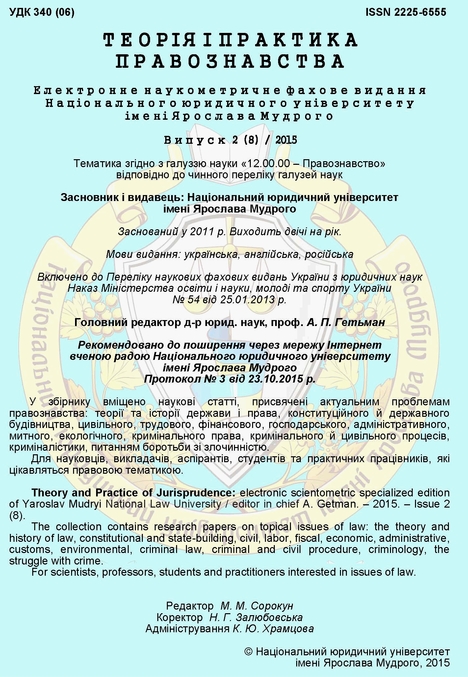Some legal aspects of complex development of underground space of megapolis
DOI:
https://doi.org/10.21564/2225-6555.2015.2.63697Keywords:
underground construction, the vertical zoning, town, urban planning, planningAbstract
Analysis of current legislation and jurisprudence practice
shows that the use of underground space of cities creates a significant number of
problems. In this article, we try to describe most typical of them.
Recent research and publications analysis. The choice of the article's subject
defined by importance of problems raised in it, some aspects of which are submitted
in works members of land law study as P.F. Kulinich, R.I. Marusenko,
A.M. Miroshnichenko A.I. Ripenko, N.V. Shulga and others.
Paper objective. The article's subject is studying of a number of law issues for
complex development of underground space.
Paper main body. Today is a time to solve problems in the field of city
development, we should refuse old forms of thinking and switch to the reasonable
limits of vertical zoning, by increasing the permissible storeys, on the basis of deepspace
organization of the whole system objects of development as the organic whole,
which consists housing and all necessary social, industrial and engineering
infrastructure, created in the underground level.
Vertical zoning should be included in the zoning plans. It should be noted that
in zoning plans must consider typology and characteristics of underground structures
through the adoption of urban planning regulations.
Except making changes in the zoning plans provisions about underground
development, should also adopt plenty of standart acts or making additions to existing
ones for underground construction. Since the law allows to decide the simultaneous
operation of aboveground and underground parts of the land area, but only "to a
certain extent", without giving specific and exhaustive answers to all questions that
arise in this regard.
There is also need to develop engineering-geological mapping of urban
underground space that will allow to evaluate the possibility of a secure building in a
particular location objects of underground space and significantly reduce the length
of the stage frills building cycle.
Underground spaces with objects placed on them are not subjects to
registration as land and can not be displayed in the cadastral system. Thus, revealed
itself the need to use some 3D features in existing cadastral system. The first step for
introduction of this system are alreadey maded, in particular, introduced by the State
Land Cadastre and the State registry, the next step will be introduction of accounting
and registration of realty objects in three dimensions.
Conclusions of the research. In Ukraine there are several problems that holds
complex development of underground space. First of all, it is a complete lack of
fundamental documents defining prospects in elaboration of underground
construction. A lot of problems are in the technical regulation: there is no regulation
requirements for construction of large number of objects just because earlier in
Ukraine there were not built at all. In addition, there are no legislative acts regulating
investment in the construction of underground structures, allocation of plots,
obtaining ownership of the facility and more.
References
Кулагин Н. И. Концепции комплексного освоения подземного пространства города / Н. И. Кулагин // Комплексное освоение подземного пространства мегаполисов – как одно из важнейших направлений государственного управления развитием территорий : сб. материалов Междунар. форума. СПб., 2012. С. 11.
Настанова про склад та зміст плану зонування території (зонінг). ДСТУ-Н Б Б.1.1-12:2011 [Електронний ресурс] : затв. наказом Міністерства регіонального розвитку, будівництва та житлово-комунального господарства України від 15 грудня 2011 р. № 345. – Режим доступу : http://dbn.at.ua/load/normativy/dstu/5-1-0-1010. – Заг. з екрану.
Международная конференция по вопросам освоения подземного пространства Москвы. Москва заглянула под землю // Архитектура и строительство Москвы. 2008. № 4. С. 7-8.
«3D Cadastre» Jantien E. Stoter. NCG, Nederlandse Commissie voor Geodesie. Delft, July, 2004. 342 p.
3D registration of real property in Denmark / J. E. Stoter, E. M. Sorensen, and L. Bodum // Proceedings of FIG Working Week, Athens, Greece, May 2004.
Developments of the 3D Cadastre in Norway. Tor Valstad // Proceedings of FIG Working Week, Munich, Germany, October 2006.
Ріпенко А. Правові аспекти використання земельних ділянок та іншої нерухомості у тривимірному просторі [Електронний ресурс] / А. Ріпенко. Режим доступу :
http://www.academia.edu/9335024/ Правові_проблеми_тривимірного_3d_кадастру_в_Україні.
Загл. з екрану.
Downloads
How to Cite
Issue
Section
License
Copyright (c) 2016 Теорія і практика правознавства

This work is licensed under a Creative Commons Attribution 4.0 International License.




